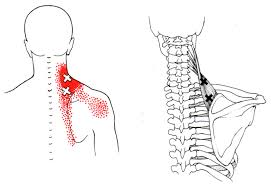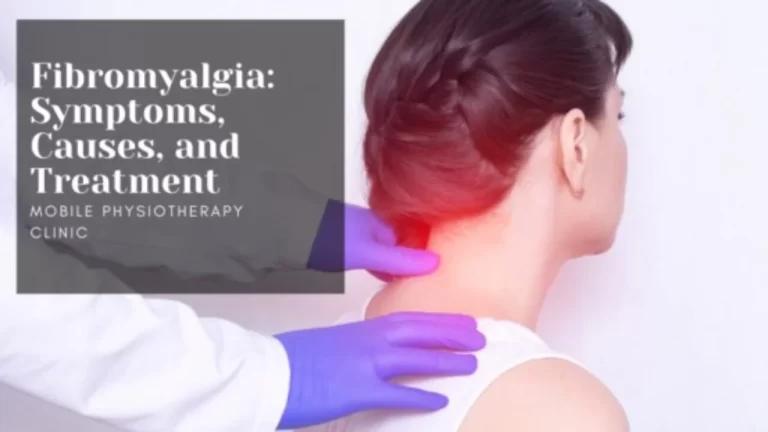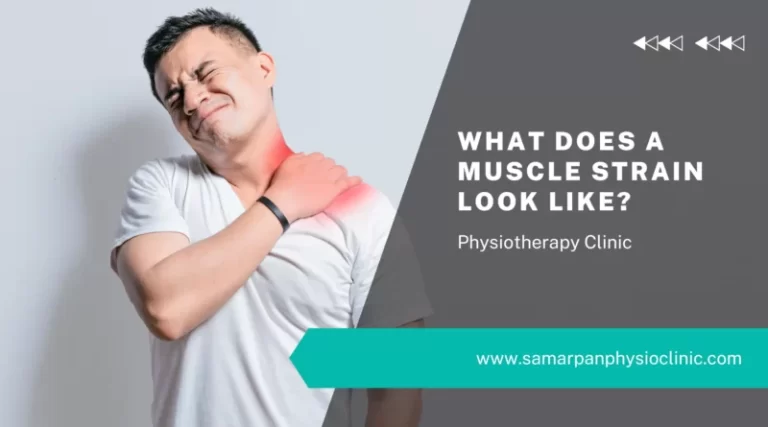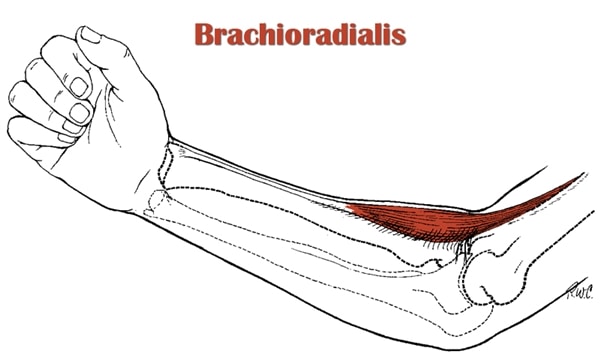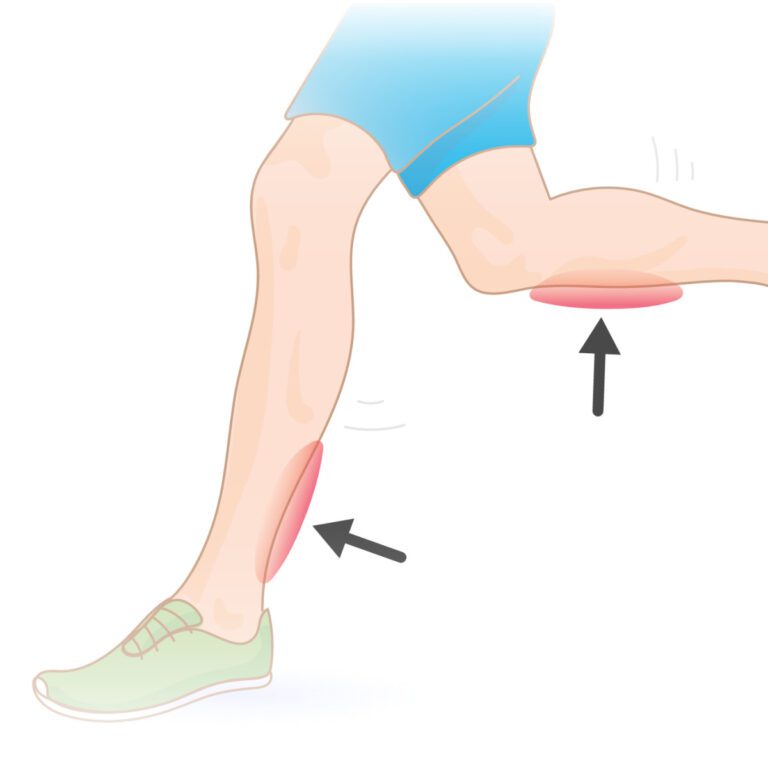Levator scapulae muscle pain: Cause, Symptoms, Treatment, Exercise
When you feel pain at the upper medial angle of the scapula bone & feel the tightness in the neck muscle, it is indicated to be Levator scapulae muscle pain.
Table of Contents
What is the Levator scapulae muscle pain?
- You feel the Pain above the upper medial angle of the scapula which is known as the Levator Scapulae Syndrome.
- One of the reasons for the muscle problems is levator scapulae muscle soreness.
- The Levator scapulae muscle pain occurs when the neck becomes stiff & tight due to a muscle strain.
- This muscle pain is produced by soreness in the muscle.
- This muscle pain is released by to rice principle, medication & physiotherapy treatment.
What is Anatomy of the levator scapulae muscle?
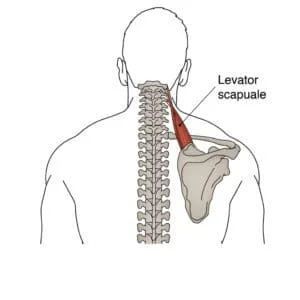
- This levator scapulae muscle originates from the posterior tubercle of the transverse process of the 1 to 4 cervical vertebrae
- This levator scapulae muscle is inserted into the medial border of the scapula which is extending from the superior angle to the junction of the spine & medial border of the scapula.
- This levator scapulae muscle is located deep in the Sternocleidomastoid muscle, deep & adjacent to the splenius capitis & mid-portion, deep to the trapezius it is the lower portion of the levator scapulae muscle.
- When your spine is fixed, this levator scapulae muscle is elevated to the scapula & rotates to the inferior angle medially.
- This muscle is always working in combination with the other muscles such as the rhomboids & pectoralis minor which are produced by the movement of downward rotation of the scapula.
- When your shoulder joint is fixed, this levator scapulae are rotates to the same side & flexes the cervical spine laterally but When both shoulders joint are not fixed, a simultaneous co-contraction of both levator scapulae muscles are in equal amounts which are not produced to lateral flexion & rotation & also produce to straight flexion/extension movement of the cervical spine.
What are the Causes of Levator Scapulae Muscle Pain?
- A most common cause of the Levator Scapulae Pain is when you Sit for a prolonged period & mostly sit with the bad posture
- When apply to continual stress & strain in the levator scapulae muscle is leading to inflammation of the muscle this stress &strain is applied to overload & do the repeating movement.
- Poor posture:
- When you Sit at a computer with a rounded shoulder which is creating a ‘hunch back’ position, it is a classic example of poor sitting posture.
- This bad posture is lead to levator scapulae muscle pain & produces irritation or pain.
- Tendinitis:
- When the injury occurs in the muscle by the daily strain & physical stress, it is called levator scapulae tendonitis which is become to cause of levator scapulae muscle pain.
- This type of muscle strain is lead to increased muscle tightness & tension.
- Repeated movement:
- When you use the repeated to the muscle by the repeated muscle contractions.
- It is lead to reduced range of motion = ROM in the neck, shoulders & arms without therapy & tension headaches.
- Depression or exhaustion & some physical issues have come with the.
- Other typical causes of the levator scapulae muscle pain include to :
- Cervical spine dysfunction
- Falls
- Whiplash from accidents
- Injuries occur in the muscle
- Repetitive arm motions.
- Some other causes which are also produced by levator scapulae pain is:
- For all-day Working on the computer with the head turned
- Carrying heavy bags with a shoulder strap
- If you are Sleeping on your stomach with your head turned
- Emotional/mental stress
- Cervical spine dysfunction.
- If the stay muscle in Chilling during sleep from a ceiling fan & air conditioner
- If you are holding a phone between the shoulder joint & ear for too long
What are the Signs and Symptoms of levator scapulae muscle injury?
- This levator scapulae muscle pain is produced by soreness in one region of the body & transmits soreness to another part of the body & vastly disparate sites.
- The main pain zones of the levator scapulae muscle are at the sides of the neck & the upper shoulder joint.
- You feel tightness in the neck muscle & over the top of the shoulder joint or between the shoulder blades.
- You experience to painful neck & impaired movement for turning to the head & lifting the neck in the supine position.
- You feel Two trigger points in the lower portion of the Levator Scapulae muscle pain.
- The lower trigger point of muscle pain is located directly above the superior angle of the scapula.
- The higher trigger point of muscle pain is located 1-3 inches above it.
- Both trigger points of the muscle pain are located too deep within the upper trapezius muscle & convey pain laterally to the shoulder blade.
- You also feel spasms & swelling around the area of muscle pain.
- You also feel weakness & numbness in the arm.
- You also feel stiffness in the muscles.
How the levator scapulae muscle is affecting the head & neck posture?
- The levator scapula muscle is performed to the principal role in retaining the shoulder blade which is configured so that promotes a vertical alignment of the head on the neck & prevents forward head posture when the head is extended too far ahead.
- The shoulder blade is a highly mobile bone by nature.
- So that it is tough to maintain the joint in a stable condition which is preserved to proper neck posture.
- In many circumstances, the cervical spine is subjected to dynamic opposing movements which demand the muscles & bones to shift independently & collaborate to keep the activity going like as Typing, staring down at a phone & sitting at a desk.
- Many people stay in a slouched position which does not provide lumbar support.
- So that if the individual’s chair is not flexibly created to ergonomic standards, so the effect of spinal alignment becomes more severe.
- These slouched postures tend to drive the shoulder blade upward & downward, stretching & elongating the levator scapulae muscle.
- As the muscles lengthen, it also becomes tenser to compensate for the loss of stability.
- Tension is usually associated with pain & a loss of tension integrity in the joint complex which is the muscle belongs.
How the levator scapulae pain is affecting the scapulohumeral Rhythm?
- Downward Rotation Scapular Syndrome is a typical clinical finding in people who have suffered from painful Levator Scapulae.
- A position like as long periods of sitting is put undue tension on the upper back muscles.
- So that muscles are stretched, the amount of pressure is exerted on them increases.
- This mid-upper corner of the scapula bone also is chronically elevated when the levator scapulae are too tense.
- When this occurs because the muscle becomes weak due to the excess tension, it begins to trigger a similar effect in the nearby muscles, which also have to over-exert themselves to compensate for the soft spot.
- When the arm is elevated, the scapula bone has difficulties upwardly rotating as needed so that kept in a downward rotated position.
- As the arm tries to rise & compression in the subacromial region is occur, causing issues in the glenohumeral joint
- As to the result, the early stages of rotator cuff damage are typical in the supraspinatus, infraspinatus, teres minor, & subscapularis, which is created as a stabilization system for the shoulder joint socket.
- If you are unnoticed by the syndrome it affects the neuromuscular system & causes the arms or shoulder joints are lose to critical motor skills of the arm.
What is the Diagnosis of levator Scapulae muscle pain?
- When you feel severe pain & discomfort in the neck movement must be contacted by to doctor as soon as possible.
- The doctor follows the assessment of the cervical spine to try to reason for the muscle pain.
- The first doctor asks you to question you about muscle pain & try to reason or cause of the muscle pain.
- In the observation, the part observes swelling & any color changes in the muscle pain.
- In the palpation, part palpates to swelling & spasms.
- The examination, part examines ROM & strengthing of the muscle.
- After the proper diagnosis, the doctor advises to treatment of the muscle depending on your condition.
What is the Treatment of the levator scapulae muscle pain?
RICE principle:
In the first stage of the pain means in the starting phase of the muscle pain doctor is advised to you follow the RICE principle.
- R – rest = When you feel pain in the neck movement must do the rest for somedays & use a thin pillow for support, you must keep & maintain the neck in a neutral position during the use computer, mobile & watching TV.rest is help to you for release to stress & overload on the muscle.
- I – Ice = You can apply to ice the area of pain for 20 minutes release pain & swellings, you can also use to ice pack & frozen peas on the area of pain but must be put to layer between to skin & ice & check the redness of the skin.
- C- compression = Also applied to compression bandage on the area of pain for release to pain & swellings.
- E- elevation = Elevation is not possible for this muscle because if do the elevation may produce pain in the neck.
Pain medication:
- When you feel the pain you take an anti-inflammatory drug which is a pain relief drug that reduces pain as a home treatment & starting phase of treatment.
- The anti-inflammatory drugs mainly NSAIDs, such as ibuprofen, and diclofenac like many drugs but depend on the severity of the pain.
- You also applied volini gel & diclofenac gel on the area of pain for the release of pain
What is physiotherapy treatment of the levator scapulae muscle pain?
The physiotherapy treatment includes massage, electrotherapy, stretching & exercise, it helps to reduce the pain & swelling.
Massage:
- Massage is applied to the tender points & trigger points of the muscle pain.
- Massage is applied with the help of the oil & powder to the area of pain.
- It is applied for 5 minutes.
- This massage helps you release pain & swelling.
Electrotherapy treatment :
The electrotherapy treatment includes SWD, TENS, IFT, and the US which is helpful to you for releasing the pain& swelling.
- To release the tender & trigger points therapist is applied US = ultrasound therapy on the area of tender pain.
- To release the pain & swelling therapist is applied SWD = short wave diathermy, IFT & TENS machine on the area of pain.
- This machine is applied for 10 minutes to the area of pain.
Stretching :
This stretching helps you to release the tightness & spasms of the muscle.
- levator scapulae muscle simple stretching
- neck Flexion Stretch
- Lateral Neck Flexion Stretch
- Cat-Back Stretch
Levator scapulae muscle simple stretching:
- The patient is Sitting up straight with both hands at the sides.
- Then Raise the right arm forward & reach over the back with the hand is grasping the right shoulder blade & applying downward pressure.
- While keeping everything else till, then rotate the head to the left about 45 degrees, which is about halfway toward the shoulder joint.
- Then Tilt the chin downward till you feel a good stretch is on the back which is the right side of the neck.
- For an increase to stretch, the left hand is brought up to the back of the head which is gently pulled down a little more.
- Hold this stretching for 30 to 60 seconds.
- Repeat this exercise on the other side.
Neck Flexion Stretch:
- This stretching is Start with a neutral position, chin elevated & shoulders dropped.
- Then Slowly drop the head forward by bringing the chin toward the chest
- Patient is feel a gentle tension up the back of the neck
- To increase the stretch, bring the arm over the head, grasp the back of the head with the hand & gently pull the head from behind Rotate the head to the right so that the chin is pointing in the direction of the right knee joint.
- Drop the chin down toward the knee.
- Then Apply gentle pressure to the back of the head with the right hand.
- The patient feels a gentle tension on the side of the back of the neck.
- For Increase the stretch by placing the left arm behind the back & toward the right hip joint.
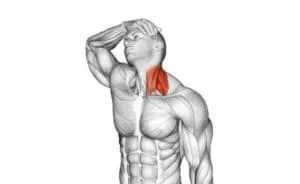
Lateral Neck Flexion Stretch:
- The patient is sitting or standing with the head in a neutral position.
- Keep the chin elevated & drop the shoulder joint.
- Then Slowly drop the right ear towards the right shoulder joint,
- Must be careful with the thing not to lift the left shoulder
- Patient feels a gentle tension on the side of the neck
- To increase the stretch, bring the right arm up & over the head.
- Grasp the left side of the head & gently pull it toward the right shoulder joint.
Cat-Back Stretch (Cervical Spine Extention):
- The patient is in a Kneeling position on hands & knees in a relaxed position
- Arch the back, relax the muscles in the neck & gently let the head drop.
- Then Reverse the pose & flatten the back or raise the head to look up at the ceiling
- Hold for a few seconds & repeat this stretching 3 times.
Exercise :
Exercise helps to relieve the pain & strengthen the muscles means a decrease in weakness.
- Shoulder Shrug exercise
- Head Rolls exercise
- Head Swings
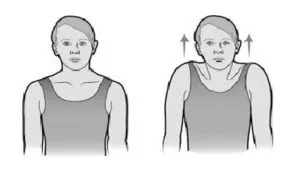
Shoulder Shrug exercise (Scapular Elevation):
- The patient is sitting/standing with the head in a neutral position.
- Must be Keep the chin elevated & drop the shoulders.
- Do the Shrug & raise the shoulder joint towards the ears.
- Must be ensured that you do not roll the shoulder joint forward.
- Hold this exercise for a few seconds, then drop the shoulder joint into the starting position.
- Then Repeat this exercise many times.
Head Rolls exercise = Cervical Spine Rotation:
- The patient is sitting/standing with the head in a neutral position.
- Must keep the chin in an elevated position or drop the shoulder joint.
- Then Slowly & gently roll the head in a clockwise circle three times.
- Repeat this exercise in the opposite direction
Head Swings:
- The patient is sitting/standing with the head in a neutral position.
- Must be Keep the chin elevated & drop the shoulder joint
- Then Slowly drop the head toward the chest & then gently roll the right ear to the right shoulder
- Bring the head back to the neutral position.
- Repeat this exercise on the other side
Strengthening exercise :
This exercise is done with the weight so this exercise is helpful to you for reducing the weakness.
- Dumbbell Shrugs
- Lateral Raises
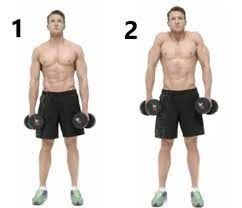
Dumbbell Shrugs:
- For this exercise, the patient is to stand with the feet shoulder-width apart.
- Then Hold one dumbbell in each hand.
- Pull the shoulder joint up towards the ears.
- Complete the three sets of 15 repetitions & 2 times in 1 week.
Lateral Raises:
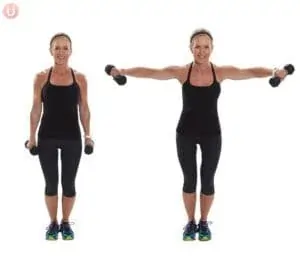
- The patient is Standing with the feet shoulder-width apart.
- Then holding a dumbbell in each hand.
- Raise the arm laterally till the elbow joint is at the same level as the shoulder joint, then lower to dumbbells.
- Complete the three sets of 15 repetitions & 2 times in 1 week.

